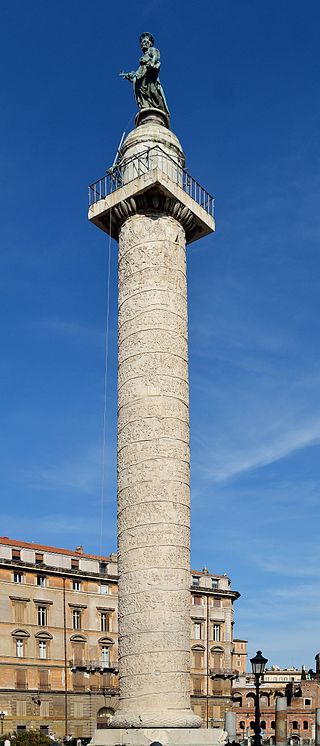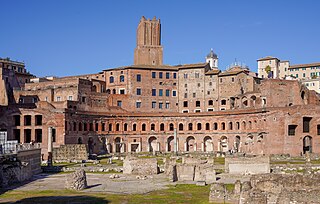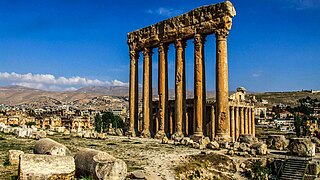
Ancient Roman architecture adopted the external language of classical ancient Greek architecture for the purposes of the ancient Romans, but was different from Greek buildings, becoming a new architectural style. The two styles are often considered one body of classical architecture. Roman architecture flourished in the Roman Republic and to an even greater extent under the Empire, when the great majority of surviving buildings were constructed. It used new materials, particularly Roman concrete, and newer technologies such as the arch and the dome to make buildings that were typically strong and well engineered. Large numbers remain in some form across the former empire, sometimes complete and still in use today.

Baalbek is a city located east of the Litani River in Lebanon's Beqaa Valley, about 67 km (42 mi) northeast of Beirut. It is the capital of Baalbek-Hermel Governorate. In 1998, the city had a population of 82,608. Most of the population consists of Shia Muslims, followed by Sunni Muslims and Christians; in 2017, there was also a large presence of Syrian refugees.

An obelisk is a tall, slender, tapered monument with four sides and a pyramidal or pyramidion top. Originally constructed by Ancient Egyptians and called tekhenu, the Greeks used the Greek term obeliskos to describe them, and this word passed into Latin and ultimately English. Though William Thomas used the term correctly in his Historie of Italie of 1549, by the late sixteenth century, Shakespeare failed to distinguish between pyramids and obelisks in his plays and sonnets. Ancient obelisks are monolithic and consist of a single stone; most modern obelisks are made of several stones.

Trajan's Column is a Roman triumphal column in Rome, Italy, that commemorates Roman emperor Trajan's victory in the Dacian Wars. It was probably constructed under the supervision of the architect Apollodorus of Damascus at the order of the Roman Senate. It is located in Trajan's Forum, north of the Roman Forum. Completed in AD 113, the freestanding column is most famous for its spiral bas relief, which depicts the wars between the Romans and Dacians. Its design has inspired numerous victory columns, both ancient and modern.

A crane is a machine used to move materials both vertically and horizontally, utilizing a system of a boom, hoist, wire ropes or chains, and sheaves for lifting and relocating heavy objects within the swing of its boom. The device uses one or more simple machines, such as the lever and pulley, to create mechanical advantage to do its work. Cranes are commonly employed in transportation for the loading and unloading of freight, in construction for the movement of materials, and in manufacturing for the assembling of heavy equipment.

A victory column, or monumental column or triumphal column, is a monument in the form of a column, erected in memory of a heroic commemoration, including victorious battle, war, or revolution. The column typically stands on a base and is crowned with a victory symbol, such as a statue. The statue may represent the goddess Victoria; in Germany, the female embodiment of the nation, Germania; in the United States either the female embodiment of the nation Liberty or Columbia; in the United Kingdom, the female embodiment Britannia, an eagle, or a naval war hero depicted as a helmeted woman, wielding a trident, shield and olive branch.

Trajan's Bridge, also called Bridge of Apollodorus over the Danube, was a Roman segmental arch bridge, the first bridge to be built over the lower Danube and considered one of the greatest achievements in Roman architecture. Though it was only functional for 165 years, it is often considered to have been the longest arch bridge in both total span and length for more than 1,000 years.

Trajan's Market is a large complex of ruins in the city of Rome, Italy, located on the Via dei Fori Imperiali, at the opposite end to the Colosseum. The surviving buildings and structures, built as an integral part of Trajan's Forum and nestled against the excavated flank of the Quirinal Hill, present a living model of life in the Roman capital and a glimpse at the restoration in the city, which reveals new treasures and insights about ancient Roman architecture.

Renaissance technology was the set of European artifacts and inventions which spread through the Renaissance period, roughly the 14th century through the 16th century. The era is marked by profound technical advancements such as the printing press, linear perspective in drawing, patent law, double shell domes and bastion fortresses. Sketchbooks from artisans of the period give a deep insight into the mechanical technology then known and applied.

Ancient Greek technology developed during the 5th century BC, continuing up to and including the Roman period, and beyond. Inventions that are credited to the ancient Greeks include the gear, screw, rotary mills, bronze casting techniques, water clock, water organ, the torsion catapult, the use of steam to operate some experimental machines and toys, and a chart to find prime numbers. Many of these inventions occurred late in the Greek period, often inspired by the need to improve weapons and tactics in war. However, peaceful uses are shown by their early development of the watermill, a device which pointed to further exploitation on a large scale under the Romans. They developed surveying and mathematics to an advanced state, and many of their technical advances were published by philosophers, like Archimedes and Heron.
Ships were used during the Eighteenth Dynasty of ancient Egypt to transport obelisks from the quarry to their destination. Fifteen centuries later, the Romans used ships to transport obelisks across the Mediterranean to Rome. Today, eight ancient Egyptian obelisks stand in Rome, though not in their original places. The first of the obelisks, the 263-ton Flaminian obelisk, was transported from Heliopolis – modern-day Cairo – in 10 BCE. while the last, the 500-ton Lateran obelisk, was transported from Karnak.

A treadwheel crane is a wooden, human powered hoisting and lowering device. It was primarily used during the Roman period and the Middle Ages in the building of castles and cathedrals. The often heavy charge is lifted as the individual inside the treadwheel crane walks. The rope attached to a pulley is turned onto a spindle by the rotation of the wheel thus allowing the device to hoist or lower the affixed pallet.

The Baalbek Stones are six massive Roman worked stone blocks in Baalbek, Lebanon, characterised by a megalithic gigantism unparallelled in antiquity. How the stones were moved from where they were quarried to their final locations is uncertain.
The Flaminio Obelisk is one of the thirteen ancient obelisks in Rome, Italy. It is located in the Flaminio quarter on Piazza del Popolo.

The Temple of Jupiter is a colossal Roman temple in Baalbek, Lebanon. It is the largest of the Roman world after the Temple of Venus and Roma in Rome. It is unknown who commissioned or designed the temple, nor exactly when it was constructed. It is most likely construction begun in the first century BC. It is situated at the western end of the Great Court of Roman Heliopolis, on a broad platform of stone raised another 7 m (23 ft) above the huge stones of the foundation, three of which are among the heaviest blocks ever used in a construction. Cultic activity had long taken place at the site; the temple presumably replaced an earlier one, possibly using the same foundation.

Lifting bosses or handling bosses are protrusions intentionally left on stones by masons to facilitate maneuvering the blocks with ropes and levers.




























